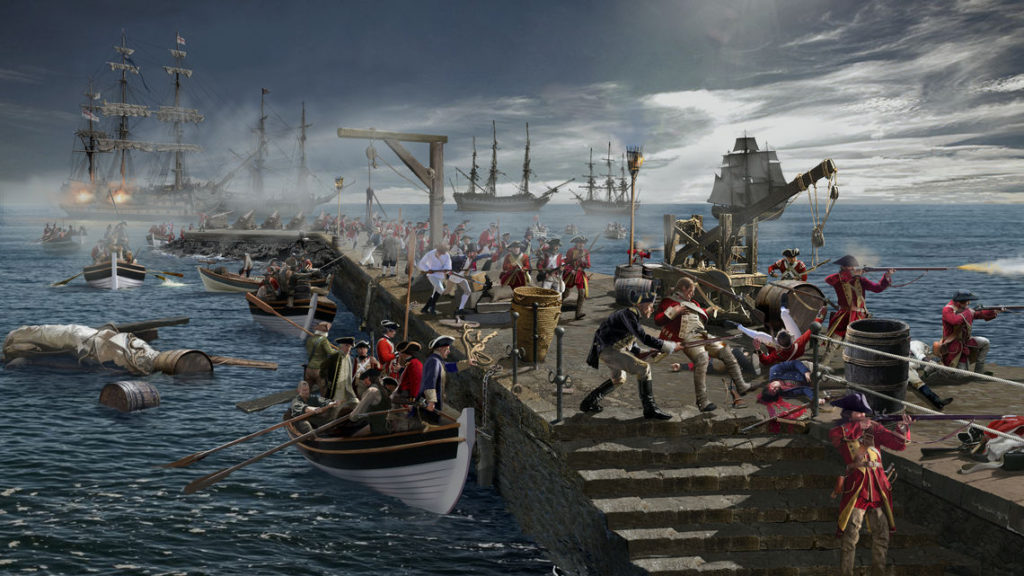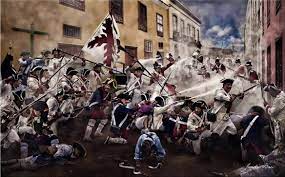
The Anglo-Spanish war of 1654 to 1660 was supposed to be the last one between these two countries, specifically since treaties were signed and ratified in 1667 and 1670. Amazingly, the uneasy truce between the two foes lasted for over 100 years, but the next Anglo-Spanish war was always going to be just around the corner.
And once again there was going to be another Battle of Santa Cruz, but this one involved land incursions, major casualties, and the wounding of the famous British Rear-Admiral Horatio Nelson in the battle of battles over Tenerife.
This upcoming assault was instigated by the defeat of the British in February of the same year, a defeat that saw valuable Spanish treasures escape the clutches of the British near Cape St Vincent in the Caribbean.
That humiliation precipitated fresh orders from on high for Admiral John Jervis to blockade the port of Cadiz, and capture the Spanish treasure that had taken shelter there.

Vice-Admiral Mazarredo in Cadiz had other ideas, sending a small flotilla of converted yachts to harass the British frigates. With their superior maneuverability in the shallow waters of the harbor, they wreaked havoc on the much bigger and more cumbersome vessels, creating gaps in the blockade that allowed their merchant ships to slip in and out with impunity.
Frustration bristled through the British fleet as months crept by without any noticeable progress. Then news filtered through to Admiral Jervis of the treasure ships regularly landing on the shores of Santa Cruz de Tenerife. Perfect, he thought.
Dispatching a newly promoted Rear-Admiral called Horatio Nelson, he waited confidently for news that the capital, and the treasure, had been captured.
Onboard HMS Theseus, Nelson set sail on 14 July with gunships, frigates and cutters, and 4,000 men ready to storm the little island with the full might of the British Empire. Failure was not an option.
The fleet’s arrival on 17 July was witnessed by the very experienced Lieutenant General Antonio Gutierrez de Otero y Santayana, who immediately issued orders to bolster the defenses. His best efforts only managed to scrape together a force of 1,700 men from local hunters, militia, and what little soldiers were stationed there.
Against the size of the invaders, they presented a token force that would not last through the first day of the invasion. Nevertheless, when Nelson dispatched a note demanding the surrender of the Spanish treasure or face destruction, the small force simply laughed at the suggestion and hunkered down for what was to come.
What Nelson had failed to take into consideration was the history of Tenerife, of brutal fighting not only against numerous invaders over the centuries, but also infighting among the 9 kings that had ruled segments of the island. All this conflict, all these battles, had forged the inhabitants into warriors that had no give in them.
Believing that victory was a foregone conclusion, Nelson dispatched 1,000 armed men in the dead of night to land at Valleseco beach, a mere two-mile march to the capital. Just before the break of dawn, even before those troops were in position, he began his siege of the harbor.

The defenders were almost caught by surprise by the British boats sneaking in but quickly began bombarding them with cannon fire from the forts. The fierce resistance was unexpected by the British and, with the strong opposing current, forced them to retreat, leaving crippled boats and bodies in their wake.
Undeterred, Nelson attacked the island from Paso Alto, another position further along the coast, but the Canarians were already hastily moving troops from Santa Cruz to the newly fortified castle constructed there more than a century ago to repel the new invaders.
Once again General Gutierrez’s men hailed down a blithering fusillade of cannon and musket fire from their fortified position, pushing the British back a second time. Admiral Nelson was enraged, gathered his captains, and informed them that he personally would lead the next attack on Santa Cruz.
In the late evening of 24 July, under cover of darkness, Nelson’s men swathed the oars in cloths to muffle their approach – and then the real battle began.
British boats reached Spanish soil, British troops landed on Spanish territory, British blood was soon staining the Spanish sand red.
It was sheer carnage. It was as if the spirits of the Guanche kings had taken possession of the men Gutierrez had placed there, turning them into ancient, fearless warriors. They were outnumbered on all fronts, were taking casualties, but were giving better than they got, decimating the ranks of the landing marines and sinking a cutter that went down with its captain and 17 sailors, all drowned.
But it wasn’t all one way for the Spanish.
Captain Bowen managed to overrun a battery of defenders covering the harbor, destroyed their guns, and proceeded to pursue them in the capital. He ran straight into a trap that saw him and several of his men cut to pieces by a hail of grapeshot. Those that survived faced the angry townspeople themselves, bullets peppering them from houses, windows, terraces, alleyways, everywhere.
Untrained they may have been with no experience of warfare, yet government officials lined up shoulder to shoulder with country peasants to defend their island, fear of the mighty British Empire overcome by their desire not to be subjugated.
It was a massacre.

In the melee elsewhere, history was about to be made, cannons booming from Spanish fortified positions, Horatio Nelson injured by grapeshot. The wound was not mortal, but the bleeding from his right arm couldn’t be stemmed and he had to retreat or risk bleeding out on the battlefield.
The surgeon was waiting for him on his return to HMS Theseus, a grim look on his face when he examined the injury. He concluded that the arm had to go, got a brief nod from Nelson, and quickly went to work with a very sharp blade. Once completed, the amputated appendage was simply thrown overboard as was the custom in those days, and the Rear-Admiral re-entered the fray.
Meanwhile, the 1,000 troops who had snuck onto the island were being bombarded and riddled mercilessly by artillerymen. Gutierrez, a veteran of many conflicts, sent his men behind the British to cut off any chance they had of retreat, then continued cutting them down ruthlessly from both fronts.
Captain Troubridge, trapped, called for reinforcements. None could get through the blockade, those that tried suffered horrible fatalities. Faced with few options, he sent a message to Gutierrez requesting that he and his surviving men be allowed to withdraw honorably under a flag of truce.
This was granted the following morning and the troops were allowed to return to their ships, and Rear Admiral Horatio Nelson had to accept defeat, had to admit that Tenerife was not his for the taking.
After days of skirmishes leading to the final conflict, the Canarians had suffered a mere 30 deaths compared to the 250 of the British who also had 128 critically wounded marines.
It was over.
Admiral Horatio Nelson had to return to England defeated, his mission of capturing Spanish gold and colonizing seven Spanish islands in an effort to control the lucrative trade routes from the Americas, beyond his capacity to achieve.
Yet still, statues of him came to adorn many cities in Great Britain, the famous Admiral posed regally minus a right arm, a poignant reminder of his battle for the little Canarian island that ended in his abject humiliation by the immovable force of the Guanche warriors of Santa Cruz de Tenerife.

